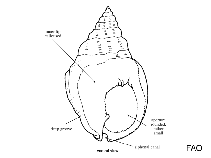|
Family Nassariidae - Nassa mud snails
|
Order |
: |
|||
Class |
: |
Gastropoda |
||
No. of Genera in Ref. |
: |
|||
No. of Species in Ref. |
: |
|||
Environment |
: |
Fresh : No |
Brackish : No |
Marine : Yes |
||
Aquarium |
: |
|||
First Fossil Record |
: |
|||
Remark |
: |
Shell ovately rounded, usually with a fairly high, conical spire and large body whorl anteriorly bordered by a strong spiral groove. Outer surface sculptured with axial ribs and spiral cords, sometimes smooth. No umbilicus. Aperture rather small and irregularly rounded, with a very short, recurved siphonal canal. Outer lip often somewhat thickened, smooth or denticulate inside, sometimes with a shallow groove or slot posteriorly. Inner lip smooth or weakly ridged but not folded, calloused and more or less expanded into a smooth shield. Operculum corneous, smaller than the aperture, with a subterminal nucleus and often serrate along margins. Head with long and extensible. Foot large, with lateral points anteriorly and typically a pair of posterior tentacles. Fleshy siphon very long. Most common on intertidal and sublittoral, temperate to tropical, soft bottoms. Mainly carrion-feeding, active animals. Can slide rapidly on sand or mud, with the fleshy siphon expanded as they search for food, or quickly bury themselves in the substrate. Often living in colonies. Sexes separate, fertilization internal. Eggs laid in corneous capsules, usually hatching as free-swimming larvae that persist relatively long (for 1 or 2 months) in the plankton before settlement. Though abundant, Nassariidae are not much exploited in the area. They can be locally used as food or bait by coastal populations, and the shells are utilized in shellcrafts. Sometimes found on local markets in the northern Philippines (Ref. 348). |
||
Etymology |
: |
|||
Division |
: |
|||
Reproductive guild |
: |
|||
Typical activity level |
: |
|||
Main Ref. |
: |
|||
Coordinator |
: |
|||
